
|
Sale 21
Pre-Long Beach Coin and Currency Auction
| Lot |
Photo |
Description |
Realized |
Lot 1015 |
 |
1853 Pattern Cent. Nickel, plain edge. PCGS graded Proof 65. Toned in deep, gray-blue toning on both sides. This extremely rare "pattern" combined a blank obverse (with denticles all around) with the reverse used on 1853 Pattern one cent pieces (Judd numbers 149-151; Pollock 178). While the Mint churned out huge numbers of Large Cents each year, they continued behind-the-scenes efforts to find a cheaper, smaller alternative -- something that would convince the public that the new coin, despite being smaller, was of equal and full value. Such an alternative was not found until 1856, when the Mint began striking the immensely popular Flying Eagle cents. Which begs the question, "Was it the design or the alloy?" This is the only example certified by PCGS, in any grade, and has no recent aution receord.
Estimated Value $3,000 - 4,000.
View details and enlarged photos
| Realized
$6,038 |
Lot 1016 |
|
1854 Pattern Cent. Copper, plain edge. NGC graded Proof 64 Red & Brown. Large Flying Eagle design. Faded fiery mint red blending with darker shades of violet cover the surfaces on both sides.
Estimated Value $900 - 1,000.
View details
| Realized
$2,990 |
Lot 1017 |
|
1858 Pattern Cent. Copper-nickel, plain edge. Proof 64. Small Flying Eagle design. Lightly toned with some faint marks scattered about.
Estimated Value $1,100 - 1,300.
View details
| Realized
$1,840 |
Lot 1018 |
|
1861 Pattern Eagle. Copper, reeded edge. PCGS graded Proof 50. Struck in copper with rose-brown color. Pop 1 in this grade. A total of 6 graded in brown by PCGS (PCGS # 60431) .
Estimated Value $2,000 - 2,300.
View details
Check results on similar lots
| Realized
$2,185 |
Lot 1019 |
|
1865 Pattern Five Cents. Nickel, plain edge. PCGS graded Proof 64. A Transitional pattern with the design adopted the following year. Well struck with semi reflective surfaces and very lightly toned. In an old green holder. Pop 8 all PR-64 (Probably many regrades) (PCGS # 60598) .
Estimated Value $8,000 - 9,000.
View details
Check results on similar lots
| Unsold |
Lot 1020 |
|
1866 Pattern Five Cents. Nickel, plain edge. Proof 64. Popular Washingnton portrait on the obverse. A brilliant example with a touch of light golden toning.
Estimated Value $2,500 - 2,800.
View details
| Realized
$2,185 |
Lot 1021 |
|
1867 Pattern Five Cents. Nickel, plain edge. NGC graded Proof 64. Lightly toned. Pop 5 with 3 higher, all PR-65.
Estimated Value $2,000 - 2,200.
View details
| Unsold |
Lot 1022 |
|
1868 Pattern Five Cents. Aluminum, plain edge. PCGS graded Proof 63. The Regular dies trial piece struck in aluminum. A very choice specimen with glittering mirror surfaces and platinum color in appearance. Pop 4 with 2 finer, all PR-64 (PCGS # 60854) .
Estimated Value $7,000 - 8,000.
View details
Check results on similar lots
| Unsold |
Lot 1023 |
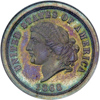 |
1868 Pattern Half Eagle. Copper, reeded edge. NGC graded Proof 65 Red & Brown. The dies were designed by Anthony C. Paquet, proposed for an international coinage, a result of a monetary conference held in Paris in 1867. Lovely brown, blue and lilac colors. 9 known. Pop 1, the only example graded by NGC.
Estimated Value $8,000 - 9,000.
View details and enlarged photos
| Realized
$9,200 |
Lot 1024 |
 |
1868 Pattern Eagle. Copper, reeded edge. NGC graded Proof 65 Brown. The stunning "perched eagle" design. Only 11 known. Beautiful iridescent shades of green, gold and lilac hues. Pop 3.This is the finest graded by NGC.
Estimated Value $7,000 - 8,000.
View details and enlarged photos
| Realized
$10,063 |
Lot 1025 |
|
1870 Pattern Dime. Silver, reeded edge. PCGS graded Proof 63 PQ. The popular Standard Silver Dime. Nicely toned near the edges. Pop 11 with 15 better, best being PR-65 (PCGS # 61081) .
Estimated Value $1,300 - 1,500.
View details
Check results on similar lots
| Realized
$1,610 |
Lot 1026 |
|
1870 Pattern Silver Dollar. Copper, plain edge. NGC graded Proof 66 Brown. Barber's rendition of Liberty seated with stars around. The surfaces are absolutely splendid and overlaid with magnificent blue and lilac iridescent toning. Pop 2 with none higher at NGC.
Estimated Value $8,000 - 9,000.
View details
| Unsold |
Lot 1027 |
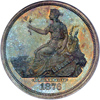 |
1876 Pattern Dollar. Copper, reeded edge. NGC graded Proof 67 Brown. A glittering Gem, mostly brown in color, with all of the mint red converted to a golden tan color, highlighted by delicate blue iridescence. Nearly perfect from a technical standpoint and most likely the finest example known of the variety. PCGS has graded only one Judd-1468, a Proof-66 RB; NGC has graded only this example.
Although muled with a "One Dollar" Pattern reverse and listed in Pollock as a Dollar Pattern, this was most likely intended as a Pattern for a Trade Dollar. Evidence pointing in this direction includes mulings with a Commercial Dollar reverse (see Judd 1496 and 1497) and a Trade Dollar reverse (see Judd 1492 and 1493). Also, the obverse design is quite similar to the regular issue Trade Dollars of years prior, but the most convincing evidence is the weight of the known silver versions of this number: Farouk's example weighed in at 419.7 grains, nearly right on the standard of 420 grains for Trade Dollars and well above the 412.5 grain standard for regular Silver Dollars.
Estimated Value $20,000 - 25,000.
View details and enlarged photos
| Realized
$44,850 |
Lot 1028 |
|
1879 Pattern Half Dollar. Silver, reeded edge. NGC graded Proof 66. Struck in silver. Featuring the famous Washlady design by Charles Barber. Here is a stunning gem example of this most sought-after silver pattern. Well struck with full mirror surfaces highlighting the raised frosty devices on both sides. The toning is superb featuring silver centers surrounded by light violet darkening to deep blue at the borders. Pop 2 this being the finest graded by NGC.
Estimated Value $18,000 - 22,000.
View details
| Unsold |
Lot 1029 |
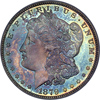 |
1879 Pattern Dollar. Silver, reeded edge. PCGS graded Proof 68. Formerly Lot 602 in our October 2000 sale, where we described it as follows: "An electric coin that is graced by deep blue toning around the periphery, with fiery yellow and red hues on both sides. The centers are lighter, and this coin has probably been stored in National Coin pages for many years, as the toning is familiar to many coins we see that have been stored that way. The surfaces are immaculate, without signs of hairlines or contact, simply put, they are perfect. We can not imagine how a finer coin could come down to us, let alone an extremely rare pattern issue. This is confirmed in the PCGS Population Report, they have graded a single coin as Proof 61, 3 as Proof 63, 2 as Proof 64, and this lone Proof 68 monster coin. It is identifiable by a small untoned spot at the top right of the S of PLURIBUS. On the reverse, the colors stagger the imagination, the periphery is dark blue with flaming yellow highlights, the centers are deep blue with lavender highlights. Of course the strike is superb, and the quality of preservation simply can not be imagined. How did this coin survive, virtually as struck, all these years? The only signs of age are the dizzying array of colors from careful storage for decades. Somehow this one escaped the cleaning frenzy of the past decades, and remains exactly as it should, perfect in every way."
Little has changed in the PCGS Population Report since 2000; the numbers cited above remain unchanged. We should remind our readers, however, that the holder is of the old, green label version, confirming that this is a premium-quality example that offers a tantalizing shot at an upgrade.
Today, our opinion of this coin has changed only in the sense that we are even more impressed by it than we were two years ago! (PCGS # 61991) .
Estimated Value $50,000 - 70,000.
Ex: From the Wayne Miller Collection, last sold by us as Lot 602 in our October 2000 sale where it realized $29,900. Since that sale, the market for U.S. Patterns has more than doubled in value due to intense competition for pieces of top quality and rarity.
View details and enlarged photos
Check results on similar lots
| Unsold |
Lot 1030 |
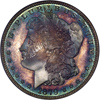 |
1879 Pattern Dollar. Silver, reeded edge. PCGS graded Proof 68. A stunning example of this rare Judd number, here bathed in dazzling rainbow iridescence. The front of the coin features a delightful lilac center that changes to incredible blue-green at the rims. The reverse features similar colors with a dash of golden iridescence for an outer ring.
The obverse features Morgan's famous design as it appears on regular issue coins of this year. The reverse is a major modification of the normal reverse, with the eagle appearing more like a pigeon than our national symbol. Interestingly enough, the motto IN GOD WE TRUST has been replaced with E PLURIBUS UNUM, which already appears in the normal position on the obverse!
In terms of quality, this is easily the technical best available to collectors and it most certainly would win any beauty contest for a Judd 1615. PCGS has graded only one example at this level, and none finer. A number of examples appear in the Proof-67 category, but we suspect some of those were resubmissions hoping to rival the grade and beauty of this piece. We doubt if a finer example will ever appear on the market, primarily because of the high rarity of this variety, plus the fact that this particular example is encapsulated in an old, green label PCGS holder (today, these older holders are generally considered to contain coins that were graded conservately by today's standards). The highest grade assigned by NGC to a Judd 1615 is "only" PR-67.
Considerable experimenting was taking place at the Mint in 1879. Different alloys were being tested (Goloid and Metric), plus consideration was being given to an international coin (the Stella $4 Gold Piece being a prime example). Thus, a raft of new designs were produced at a time when the question of the design on the Morgan Dollar had already been settled. Considering the legal requirements governing design changes, a lot of energy was expended in a seemingly wasted fashion. Not a single one of the 1879 Pattern designs was adopted!
A foremost rarity in all grades and seldom offered for sale. This coin will be the centerpiece of any pattern collection and a fantastic display piece, as well (PCGS # 61993) .
Estimated Value $50,000 - 70,000.
Ex: From the Wayne Miller Collection, last sold by us as Lot 603 in our October 2000 sale, where it realized $25,300. Since that sale, the market for U.S. Patterns has more than doubled in value due to intense competition for pieces of top quality and rarity.
View details and enlarged photos
Check results on similar lots
| Unsold |
Lot 1031 |
|
1879 Pattern Metric Dollar. Silver, reeded edge. PCGS graded Proof 64 PQ. Goloid Metric Dollar. Reeded edge. Bright mirror surfaces with just a touch of light tone. In an old green PCGS holder (PCGS # 61995) .
Estimated Value $4,500 - 5,000.
View details
Check results on similar lots
| Unsold |
Lot 1032 |
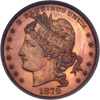 |
1879 Pattern Goloid Metric Dollar. Copper, reeded edge. PCGS graded MS-65 Red. A beautiful Pattern piece, essentially full red in color. Obverse and reverse designs never adopted. Housed in an old, green-label holder. PCGS reports 2 in MS-65 Red (quite possibly the same coin submitted twice).
"Goloid" refers to the unusual mix of gold, silver, and copper intended for actual coinage, this being a pure copper version. The "Metric" refers to the system of weights (grams) used on these coins. Beginning with the Act of 1873, the Mint began an active campaign to introduce and utilize the metric system on American coins. The first efforts were directed at coins already in circulation (the arrowheads on the 1874 Dimes, Quarters, and Half Dollars all point to the conversion of the weight from grains to grams). The first coin to bear the word "grams" was Bickford's "UBIQUE" Eagle of 1874. In 1878, mixed efforts continued, but it was not until 1879 that the Mint really began to explore the possibilities of converting to the metric system. This Goloid Metric Dollar is one result, as are the amazing Stellas and Quintuple Stellas. More attempts were made in 1880, but by 1881, all efforts were dropped and the word "gram" never appeared on a Pattern coin again!
Estimated Value $8,000 - 10,000.
View details and enlarged photos
| Realized
$9,488 |
Lot 1033 |
 |
1882 Pattern Quarter Dollar. Copper, reeded edge. PCGS graded Proof 65 Red & Brown. One of the prettiest and most popular of all Pattern designs, yet neither side ever made it onto a regular issue coin. The obverse features Miss Liberty with a hairband tight around the back of her head, wearing a Union shield as an earring. On the reverse, a defiant eagle clutches the usual olive branch and cluster of arrows. Listed as High Rarity-7, but this variety hardly ever appears at auction. At this graded level, PCGS has graded only a single example, with none finer.
Estimated Value $14,000 - 18,000.
View details and enlarged photos
| Realized
$26,450 |
Lot 1034 |
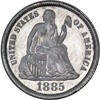 |
1885 Pattern Dime. Aluminum, reeded edge. PCGS graded Proof 67 Cameo. Aluminum version of an 1885 Dime, using the regular obverse and reverse dies. The term "die trial" is inappropriate here, as these were made as part of complete sets of 1885 coins struck in Aluminum. Nevertheless, these are collected as important pieces in the U.S. Pattern series and as highly-regarded rarities. A superb Gem, the finest (by three points) of only two examples of this variety graded by PCGS! (PCGS # 62186) .
Estimated Value $7,000 - 10,000.
View details and enlarged photos
Check results on similar lots
| Unsold |
Lot 1035 |
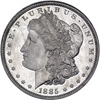 |
1885 Pattern Dollar. Aluminum, lettered edge. PCGS graded Proof 66 Cameo. Incredible brilliance and luster. Razor sharp strike (imagine the soft metal being squeezed into every nook and cranny of the dies). Small lamination bubble by OL of DOLLAR. This pattern used the normal dies of an 1885 silver dollar to test a new, experimental, three-part collar developed by Col. A.L. Snowden of the Mint. Snowden was very proud of his invention and showed it to Henry Chapman, who recounted the following anecdote in his 1916 sale of the Bement collection: "A.L. Snowden's invention…which he exhibited to me with great pride; was going to have it patented and revolutionize the World's Coinage until I exhibited to him a crown of Oliver Cromwell, and showed him where Thos. Simon had made a better job of it two hundred and thirty-seven years before. The Col. collapsed forthwith."
PCGS reports two examples in this grade and 1 finer (a Proof-67) (PCGS # 62191) .
Estimated Value $10,000 - 13,000.
View details and enlarged photos
Check results on similar lots
| Realized
$13,225 |
|
|